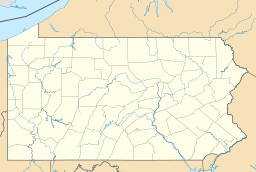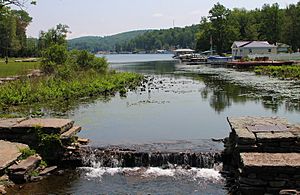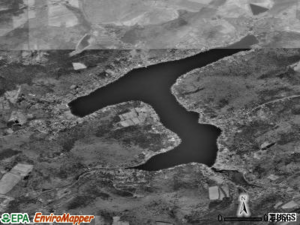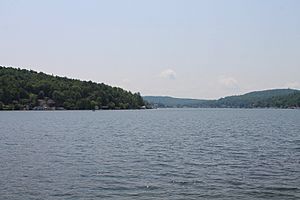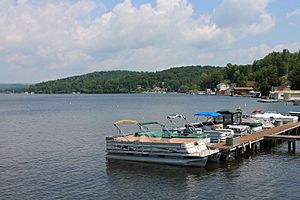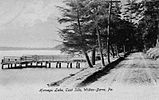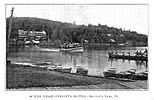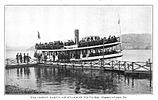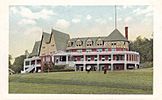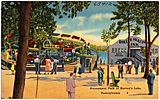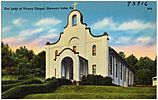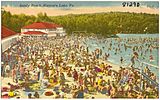Harveys Lake (Pennsylvania) facts for kids
Quick facts for kids Harveys Lake |
|
|---|---|
| Harvey Lake, Harvey's Lake | |

Harveys Lake from the south
|
|
| Location | Harveys Lake, Luzerne County, Pennsylvania |
| Coordinates | 41°21′54″N 76°02′31″W / 41.365°N 76.042°W |
| Type | glacial lake |
| Etymology | Named after Benjamin Harvey, its discoverer |
| Primary inflows | two unnamed streams, several springs |
| Primary outflows | Harveys Creek |
| Catchment area | ~3,600 acres (1,500 ha) |
| Basin countries | Luzerne County, Pennsylvania; Wyoming County, Pennsylvania |
| Max. length | 15,640 feet (4,770 m) |
| Max. width | 4,960 feet (1,510 m) |
| Surface area | 621.5 acres (251.5 ha) |
| Average depth | 36 feet (11 m) |
| Max. depth | 102 feet (31 m) |
| Water volume | 7.733 billion US gallons (6.439×109 imp gal; 29.27 hm3) |
| Residence time | 1116 days |
| Shore length1 | 8.3 miles (13.4 km) |
| Surface elevation | 1,253 feet (382 m) |
| 1 Shore length is not a well-defined measure. | |
Harveys Lake, also called Harvey Lake, is a beautiful natural lake in Luzerne County, Pennsylvania. It's a big lake, covering about 621.5 acres, which is almost a square mile! Harveys Lake is special because it's the largest natural lake in Pennsylvania by how much water it holds. It's also the second largest by its surface area.
This lake was formed by glaciers long ago and is surrounded by tall hills. It's the starting point for Harveys Creek, a stream that flows into the Susquehanna River. A stone dam helps manage the lake's water. The land around the lake that drains into it, called its watershed, is about 3600 acres. Most of this area is covered by forests, but there are also developed areas, especially close to the lake. A paved road goes all the way around the lake.
Since the mid-1900s, Harveys Lake has faced issues with algae blooms. These blooms happen when too many nutrients, like phosphorus, get into the water. The lake was identified as having problems in 1994. However, efforts have been made to reduce the amount of phosphorus. Harveys Lake is listed in the Luzerne County Natural Areas Inventory because of its importance. You can find rare and endangered plants, many types of fish, and various birds living near the lake.
Benjamin Harvey accidentally found Harveys Lake in 1781. The first people settled near the lake in the late 1700s and early 1800s. At first, people worked in lumber and farming. But later, in the late 1800s and early 1900s, it became a very popular summer resort. It was also used to supply water in the early 1900s. However, environmental problems started in the 1960s. Since 1968, the lake has been part of the borough of Harveys Lake.
Contents
Exploring Harveys Lake's Geography
Harveys Lake is the biggest natural lake in Pennsylvania by volume. It's also the second largest by its surface area. The lake covers 621.5 acres. Its average depth is 36 feet (11 meters), and it goes down to a maximum of 102 feet (31 meters). The shoreline of the lake stretches for about 8.3 miles (13.4 km). When it was first measured in the late 1700s, the lake was about twice its current size.
Harveys Lake is located entirely within the borough of Harveys Lake. It's about 12 miles (19 km) northwest of the city of Wilkes-Barre.
How Harveys Lake Was Formed
Harveys Lake was formed by glaciers. It is surrounded by steep hills on all sides. The highest hills are to the south of the lake, rising about 410 feet (120 meters) above the lake's surface. The bottom of the lake is made of gravel.
The main stream flowing out of Harveys Lake is Harveys Creek. This creek is a tributary of the Susquehanna River. Two unnamed streams, about 4 to 8 feet (1.2 to 2.4 meters) wide, flow into the lake. They are about 6 inches (15 cm) deep. Many springs also feed the lake. The lake sits 1253 feet (382 meters) above sea level. It is in north-central Luzerne County.
In 1921, a book described Harveys Lake as having a "very irregular" shape. The lake is about 15,640 feet (4,770 meters) long and 4,960 feet (1,510 meters) wide at its widest points. It holds about 7.733 billion US gallons (29.27 million cubic meters) of water. Harveys Lake has a stone dam with two spillways. The dam is 120 feet (37 meters) long and 4 feet (1.2 meters) high.
Henry C. Bradsby's 1893 book, History of Luzerne County, Pennsylvania, called Harveys Lake "one of the most beautiful" lakes in Pennsylvania.
Understanding the Harveys Lake Watershed
Harveys Lake is found on maps from the United States Geological Survey. The area of land that drains into the lake, called its watershed, is about 3600 acres. Most of this watershed is in Luzerne County, but a small part in the northeast is in Wyoming County.
Most of the land in the Harveys Lake watershed, about 2841 acres, is covered by forests. Developed areas and farmland make up 499 acres and 154.7 acres, respectively. There are also 2.5 acres of Unpaved roads. Most of the developed land is right along the shoreline. Nearly all of it is within 0.5 miles (0.80 km) of the lake. This developed land is mostly used for homes and businesses.
One developed area is called Hemlock Gardens. It covers 28 acres and has 26 homes. This area has steep slopes and unpaved roads, and it used to have problems with stormwater. However, new equipment was installed to help clean the water. This has reduced the amount of phosphorus flowing into Harveys Lake by about 36 pounds (16 kg) each year.
A paved road completely circles the shoreline of Harveys Lake. This is unusual for a lake. Homes and cottages are built along this road, across from the lake. A lot of building has happened near the lake. There's also a concrete ditch and drain at Wardens Place that helps control small floods from the road.
Harveys Lake's Water Quality and Flow
In 1893, Harveys Lake's water was described as "very pure." However, since the mid-1900s, the lake has had problems with nutrient pollution, especially from phosphorus. This has caused algae blooms and made the water quality worse throughout the late 20th century. A sewage system was put in place in 1976, but it didn't completely stop the algae blooms. Still, the amount of phosphorus in the lake has been reduced by 29 percent.
In 1994, the lake was identified as "impaired." This means it wasn't as healthy as it should be, mainly because of large algae blooms and sedimentation in some areas. It is an anoxic lake, meaning it sometimes lacks oxygen deep down.
In the 1990s, the amount of phosphorus in Harveys Lake was measured at 0.031 milligrams per liter. The lake's goal for phosphorus is 0.024 milligrams per liter. This is part of a plan called a total maximum daily load (TMDL), which aims to limit pollution.
The water in Harveys Lake stays in the lake for about 1116 days before flowing out. The lake helps reduce big floods in Harveys Creek. You can usually see about 10 feet (3.0 meters) into the lake's water. Sometimes, it's as low as 5 feet (1.5 meters) or as clear as 15 feet (4.6 meters).
History and Fun at Harveys Lake
Harveys Lake was officially added to the Geographic Names Information System on August 2, 1979. Lake Township is named after the lake.
The lake is named after Benjamin Harvey. He was a member of the Sons of Liberty and one of the first settlers in the Wyoming Valley. Harvey accidentally found the lake in 1781. He was on his way home after being held captive at Fort Niagara. The first person to live near the lake was Matthew Scouten in the early 1790s. The first settlers, the Worthingtons, arrived in 1806. Christopher Hurlbert first surveyed the lake in 1794. Andrew Bennett was the first European to explore the lake by canoe in 1800.
From Lumber to Resort Life
Early settlers near Harveys Lake mostly worked in lumber and farming. At one point in the 1800s, mills near the lake were cutting over a million board feet of lumber every year. But by 1853, summer resorts started to appear near the lake. People from the Wyoming Valley came to visit. Hotels like the Lake House Hotel, and later the Rhoads Hotel, the Lake Grove Hotel, and the Grand Hotel Oneonta, were popular in the late 1800s. The Grand Hotel Oneonta was very famous in the early 1900s. Even former United States President Theodore Roosevelt visited it in August 1912. In the early 1900s, there were three hotels, two hundred cottages, and sixty boathouses on the lake. Most of them were at least 15 feet (4.6 meters) above the water.
A railroad line, the Harvey Lake and Towanda Branch of the Lehigh Valley Railroad, was built in the late 1800s. It went directly from Wilkes-Barre to Harveys Lake. In the 1890s, more railroad lines connected the lake to Pittston and Towanda.
Fun Activities and Modern Use
Harveys Lake has been a popular spot for fun since the late 1800s. Places like Warden Place and Sandy Beach were popular recreation areas in the early 1900s. Around this time, four steamboats carried passengers and goods on Harveys Lake. Steamboat rides were very popular between 1900 and 1920. A 60-foot (18-meter) high Shoot the Chute ride was built by Charles Shelley in 1910. It was one of the biggest attractions near the lake. A casino opened in May 1924 but was torn down in 1980. The owner also opened the largest bowling alley in northeast Pennsylvania near the lake. Throughout the 20th century, thousands of visitors came to the lake every year.
In the early 1900s, Harveys Lake was used to supply water to Nanticoke. It also provided ice and was a popular summer resort.
Scientists have been studying Harveys Lake since the late 1940s. By the 1960s, the lake started having environmental problems. Studies in the late 1980s and early 1990s showed that the lake was eutrophic. This means it had too many nutrients. Algae blooms caused the lake to be closed for swimming in 1981 and 1990. The Pennsylvania Department of Environmental Protection created a plan to reduce phosphorus in 2002.
Today, people enjoy swimming, fishing, and boating at Harveys Lake. However, there are no public places for SCUBA diving. The lake is one of the most used lakes in the area. It has been part of the borough of Harveys Lake since January 1, 1968. In 2004, a plan to build 30 boat slips near the lake was opposed due to safety and environmental concerns.
Historical gallery
Plants and Animals of Harveys Lake
Harveys Lake is listed on the Luzerne County Natural Areas Inventory. This means it's an important place for nature.
Plant Life Around the Lake
Many rare or endangered plant species have been seen near Harveys Lake. Some plants found here include Vasey's pondweed, flat-leaved pondweed, grassy pondweed, broad-leaved water-milfoil, and Beck's water-marigold. However, some non-native and invasive plants, like fanwort and aquatic coontail, also live in the area. These plants have changed the natural habitat. You can also find Second-growth forests around the lake.
As mentioned before, algae blooms have happened on Harveys Lake. These occur because of high levels of nutrients in the water.
Fish and Birds of Harveys Lake
Harveys Lake is home to many different kinds of native fish found in Pennsylvania. In 1972, Field and Stream magazine noted that the lake had rainbow trout, sockeye salmon, and some lake trout. The area of Harveys Creek upstream of Pikes Creek is known as a High-Quality Coldwater Fishery. This means Harveys Lake also has this special designation. For fishing, there are rules about how many trout you can catch. You can keep three trout per day, but only one can be longer than 18 inches (46 cm).
Many different bird species have been seen near Harveys Lake. These include surf scoters and black scoters, which visit in the winter. While greater scaups are rare in Pennsylvania away from Lake Erie, one was seen at the lake in July 1992. Franklin's gulls have also been observed near the lake. Other birds include snow buntings, black-legged kittiwakes, and ruddy ducks. Nine brant geese were seen on the lake in May 1997.


